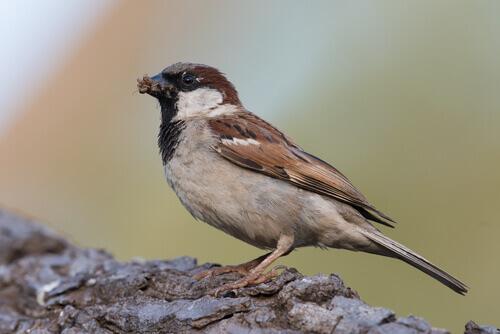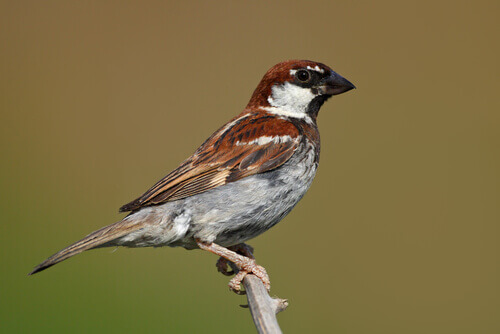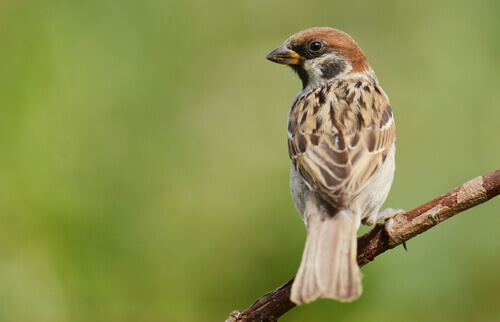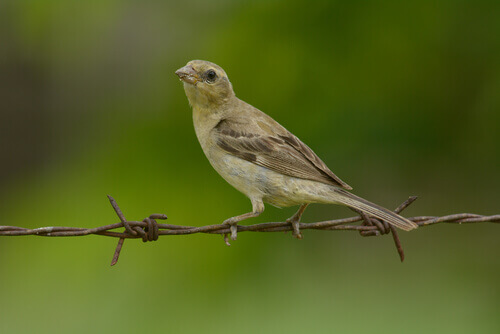Characteristics of the Sparrow Family

Sparrows are well-known for their lovely singing and also because they inhabit urban areas and aren’t afraid of people. This bird is small and they’re now spread almost all over the world. We’ll tell you all about this beautiful bird in this article.
General characteristics of the sparrow family
The sparrow is a songbird, which, as its name suggests, is given to singing. Passerines -their scientific identification- are used to urban life. These animals now inhabit most continents (except Antarctica) thanks to humans but are originally from Eurasia and North Africa.
They’re small, robust, and their beaks are thick and their legs thin. In addition, their diet consists of grains, seeds, and bugs. Furthermore, they’ve acquired a taste for bread, fruit, and vegetables, given that they inhabit large cities.
Male sparrows are more conspicuous than females in terms of the mantle. In addition, only male sparrows can sing. This is how they attract mates. Unfortunately for them, this characteristic also makes them easier prey for predators, such as cats.
Females have dull-colored feathers so they camouflage with their environment. This allows them to safely incubate eggs.
The sparrow family
This songbird, which is most abundant in parks and urban gardens, has many subspecies and these are similar to each other, both in plumage and morphology and also habits. Some of them are:
1. House sparrow
The official name of this little guy is Passer domesticus (main picture) and has a robust body with short legs and a thick, strong beak. It measures about 6 inches and weighs about 1.05 ounces. It’s sedentary, monogamous and gregarious, and hangs out in places frequented by people.
The mantle of the males is gray on the belly, has a large black spot on the chest and throat and the head is reddish with brown feathers; the legs are pink. Females are light brown on the belly and dark on the feathers and tail; they also have pink legs, but the beak isn’t as dark as that of the males.
2. Italian sparrow
Also known as the house sparrow, this bird inhabits most areas of the Mediterranean basin, although there’s a greater predominance in Italy. It’s a cousin of the house sparrow and, thus, looks quite similar.

The males have a nicely-shaped head, with a chestnut crown and a white head, cheeks, and nape. Their underparts are dark gray and their upper parts a bright chestnut. In contrast, the body of the females is almost entirely brown — in different shades.
They get to be about 6 inches and weigh about 1 ounce and are quite social. Their diet consists of bugs and seeds, they don’t migrate in the winter, and mates can produce between two and eight eggs.
3. Tree sparrow family
Their heads are brown and the cheeks white while the chin, beak, and eyes are black. Moreover, the belly is either white or light brown -like the tip of the tail- and the feathers are also brown. This species doesn’t present sexual dimorphism but the youngsters are darker.

This bird is common in cities in East Asia and in forests and open fields in Europe. The tree sparrow eats seeds and invertebrates, and birds of prey are its main predators.
The animal builds a nest using hay, grasses, and feathers in either tree cavities, walls, or cliffs. Also, the pairs are monogamous and breed between April and May. In fact, each pair produces about five white, spotted eggs.
4. Plain-backed sparrow
Also known as Pegu’s sparrow, this bird inhabits Indochina and Southeast Asia, specifically Vietnam, Thailand, Myanmar, Malaysia, Cambodia, and Laos. People usually spot them in plantations and gardens, where they eat seeds.

The plain-backed sparrow has a brown and yellow mantle. The males have black patches on the throat. The beaks of both sexes are shiny gray and their legs black. The mates build their nests with grasses, and the mother lays between three and seven eggs, which she incubates for three weeks, each year. Both parents take turns feeding the chicks.
5. Lago sparrow
Also known as the great sparrow, this bird is endemic to the Cape Verde archipelago. It measures about 5 inches and has sexual dimorphism like most of its family. Males have white bellies, black-orange heads, black tails, and dark gray feathers. Meanwhile, the females are gray with black markings.